Florence Churches – Chiese di Firenze
- Maria Scuor
- Dec 7, 2024
- 12 min read
Italiano sotto ogni sezione
We spent a wonderful couple of days in Florence with Tashya and Nicolas and got to see some amazing architecture. In the downtown core there are about 50 churches and this blog is about the four stunning churches we saw.
Abbiamo trascorso un paio di giorni meravigliosi a Firenze con Tashya e Nicolas e abbiamo avuto modo di vedere alcune architetture incredibili. Nel centro della città ci sono circa 50 chiese e questo blog parla delle quattro splendide chiese che abbiamo visto.
Florence Cathedral – Duomo di Firenze
Like most Cathedral’s in Italy, you need to purchase tickets in advance to visit the Cathedral inside. Even in October when we went, there were so many people that you could hardly walk without bumping into someone and the tickets to get into the Cathedral were eight days out.
The Florence Cathedral or Saint Mary of the Flower was conceived in 1293 and took over 140 years to build because the initial technology to complete the dome was not solid therefore the roof was left exposed for several years before being completed in 1436. Arnolfo di Cambio designed it in Gothic style, the dome was completed by Filippo Brunelleschi and the Gothic Revival façade by Emilio de Fabris.
The complex sits in Piazza del Duomo and includes the Cathedral, the Baptistery and Giotto’s Bell Tower. These three building became along with the historic centre of Florence became part of the UNESCO World Heritage Site in 1982.
Some facts about the cathedral
Built as a basilica – has wide central nave of four-square bays, an aisle on each side. The chancel and transepts are of identical polygonal plan with to small chapels. It forms a Latin cross. The building is enormous and it has the fifth tallest dome in the world
World largest masonry dome – Almost 600 years later Filippo Brunelleschi's dome, reigns as the largest masonry dome. Built without any plans or sketches, it continues to mystify Brunelleschi's unparalleled architectural genius
Built on top of Santa Reparata – the cathedral is built on the remnants of the modest Santa Reparata church built between the 4th and 6th century. You can see artifacts, tapestry and religious history if you visit the underground museum
The Gates of Paradise – are the gates of the Baptistery that were completed in 1401 and designed by Lorenzo Ghiberti. Ghiberti's classical style was favoured over Filippo Brunelleschi's style and later, Michelangelo remarked that they seemed like the “gates of paradise”
Brunelleschi won the competition – in August 1418, a competition was held on who would build the dome of the basilica and legend has it he won the competition without showing any designs. He just had an egg and he told the committee he would reveal his designs if any of them could make an egg stand on the table. After they failed, he cracked the egg’s bottom, making it stand. This witty move secured his victory
Brunelleschi's goldsmith skill – Filippo didn’t have architectural skill but as a skilled goldsmith harnessed the artistry of aesthetics and practicality intrinsic to goldsmithery. This unique perspective defied expectations and built the timeless masterpiece that is the Duomo's dome
Third largest cathedral – only surpassed by St. Peter’s in Rome and St. Paul’s in London
Dome completed in 16 years - In an era where architects seldom witnessed their work's completion, Brunelleschi's swift success marked a groundbreaking achievement, showcasing his visionary brilliance and leaving an indelible mark on architectural history
Evolution of the façade - Originally designed by Arnolfo di Cambio in 1294, the facade had corruption scandals and remained incomplete until 1887. Emilio de Fabris finalized the neo-Gothic design, using diverse marbles from Tuscany and Italy, crafting the mesmerizing exterior seen today
Climbing the cathedral – to complete the full experience you can climb 463 steps to one of the best views in the city. However, this climb isn’t for everyone, the stairs were built to help workers during the construction and for maintenance, not for the general public. They are small and narrow and if you’re not a lover of long hikes, stairs, small spaces and heights this isn’t a climb for you
Exterior Photos – Foto Esterne
Interior photos thanks to Wikipedia - Foto degli interni grazie a Wikipedia
Duomo di Firenze
Come la maggior parte delle cattedrali in Italia, è necessario acquistare i biglietti in anticipo per visitare la Cattedrale al suo interno. Anche a ottobre, quando siamo andati, c'era così tanta gente che a malapena si poteva camminare senza imbattersi in qualcuno e i biglietti per entrare nella Cattedrale erano a otto giorni di distanza.
Il Duomo di Firenze, o Santa Maria del Fiore, fu concepito nel 1293 e ci vollero più di 140 anni per costruirlo perché la tecnologia iniziale per completare la cupola non era solida, quindi il tetto fu lasciato a vista per diversi anni prima di essere completato nel 1436. Arnolfo di Cambio la progettò in stile gotico, la cupola fu completata da Filippo Brunelleschi e la facciata neogotica da Emilio de Fabris.
Il complesso si trova in Piazza del Duomo e comprende la Cattedrale, il Battistero e il Campanile di Giotto. Questi tre edifici sono entrati a far parte del Patrimonio dell'Umanità dell'UNESCO nel 1982, insieme al centro storico di Firenze.
Alcuni fatti sulla cattedrale
Costruito come una basilica - ha un'ampia navata centrale di quattro campate quadrate, una navata su ciascun lato. Il presbiterio e i transetti sono di identica pianta poligonale con piccole cappelle. Forma una croce latina. L'edificio è enorme e ha la quinta cupola più alta del mondo
La cupola in muratura più grande del mondo – Quasi 600 anni dopo, la cupola di Filippo Brunelleschi, regna come la più grande cupola in muratura. Costruito senza alcun piano o schizzo, continua a mistificare l'ineguagliabile genio architettonico del Brunelleschi
Costruita sopra Santa Reparata – la cattedrale è costruita sui resti della modesta chiesa di Santa Reparata costruita tra il IV e il VI secolo. È possibile vedere manufatti, arazzi e storia religiosa se si visita il museo sotterraneo
La Porta del Paradiso – sono le porte del Battistero che furono completate nel 1401 e progettate da Lorenzo Ghiberti. Lo stile classico di Ghiberti fu privilegiato rispetto a quello di Filippo Brunelleschi e in seguito, Michelangelo osservò che sembravano le "porte del paradiso"
Brunelleschi vinse il concorso – nell'agosto del 1418 si tenne un concorso su chi avrebbe costruito la cupola della basilica e la leggenda narra che vinse il concorso senza mostrare alcun disegno. Aveva appena preso un uovo e disse alla commissione che avrebbe rivelato i suoi disegni se qualcuno di loro fosse riuscito a far stare un uovo sul tavolo. Dopo che hanno fallito, ha rotto il fondo dell'uovo, facendolo stare in piedi. Questa mossa spiritosa gli assicurò la vittoria
L'abilità orafa di Brunelleschi – Filippo non aveva abilità architettoniche ma, come abile orafo, ha sfruttato l'arte dell'estetica e la praticità intrinseche all'oreficeria. Questa prospettiva unica ha sfidato le aspettative e ha costruito il capolavoro senza tempo che è la cupola del Duomo
Terza cattedrale più grande – superata solo da San Pietro a Roma e San Paolo a Londra
Cupola completata in 16 anni - In un'epoca in cui gli architetti raramente assistevano al completamento delle loro opere, il rapido successo di Brunelleschi segnò un risultato rivoluzionario, mettendo in mostra la sua genialità visionaria e lasciando un segno indelebile nella storia dell'architettura
Evoluzione della facciata - Originariamente progettata da Arnolfo di Cambio nel 1294, la facciata subì scandali di corruzione e rimase incompiuta fino al 1887. Emilio de Fabris finalizzò il design neogotico, utilizzando diversi marmi provenienti dalla Toscana e dall'Italia, realizzando l'affascinante esterno che si vede oggi
Salire sulla cattedrale – per completare l'esperienza completa puoi salire 463 gradini fino a una delle migliori viste della città. Tuttavia, questa salita non è per tutti, le scale sono state costruite per aiutare gli operai durante la costruzione e per la manutenzione, non per il pubblico in generale. Sono piccole e strette e se non siete amanti delle lunghe escursioni, delle scale, dei piccoli spazi e delle altezze questa non è una salita che fa per voi
St. Lawrence Basilica – Basilica di San Lorenzo
Once again, we were not able to visit the basilica but it’s grandeur can be seen from the outside. One of the largest churches in Florence, it is located at the centre of the main market district. Being consecrated in 393 AD, it claims to be one of the oldest churches in Florence. Before the current cathedral, it was the cathedral of Florence for 300 years.
St. Lawrence was the parish of the wealthy banking and political Medici family and in 1419, Giovanni di Bicci de’ Medici financed the replacement of the 11th century church. Filippo Brunelleschi started the project in Renaissance style but after his death in 1446 either Antonio Manetti or Michelozzo completed it in 1459.
The façade was commissioned to Michelangelo in 1518 and built a wooden model however it was never built. He did build the internal façade of the basilica that is seen from the nave looking back toward the entrances. There have been many attempts by the city of Florence to complete the external façade according to Michelangelo’s design, but as of yet no decisions have been made to move forward. In 1976, a concealed corridor with drawing by Michelangelo. It was believed he hid there when he was sentenced to death by the Medici for rebelling against them in 1530. He was pardoned in 1534 to work on the Sistine Chapel and Medici family tomb in Rome.
The grandest part of this church is the Medici Chapels in the apse which has they crypt of the Medici family and relics of about 50 family members.
Exterior photos – Foto esterne
Interior photos thanks to Wikipedia - Foto degli interni grazie a Wikipedia
Basilica di San Lorenzo
Ancora una volta, non siamo stati in grado di visitare la basilica, ma la sua imponenza può essere vista dall'esterno. Una delle chiese più grandi di Firenze, si trova al centro del principale quartiere del mercato. Consacrata nel 393 d.C., sostiene di essere una delle chiese più antiche di Firenze. Prima dell'attuale cattedrale, è stata la cattedrale di Firenze per 300 anni.
San Lorenzo era la parrocchia della ricca famiglia bancaria e politica dei Medici e nel 1419 Giovanni di Bicci de' Medici finanziò la sostituzione della chiesa dell'XI secolo. Filippo Brunelleschi iniziò il progetto in stile rinascimentale, ma dopo la sua morte nel 1446 Antonio Manetti o Michelozzo lo completarono nel 1459.
La facciata fu commissionata a Michelangelo nel 1518 e ne costruì un modello in legno, ma non fu mai costruita. Fece costruire la facciata interna della basilica che si vede dalla navata guardando indietro verso gli ingressi. Molti sono stati i tentativi da parte della città di Firenze di completare la facciata esterna secondo il progetto di Michelangelo, ma finora non è stata presa alcuna decisione in tal senso. Nel 1976, un corridoio nascosto con disegno di Michelangelo. Si crede che vi si sia nascosto quando fu condannato a morte dai Medici per essersi ribellato contro di loro nel 1530. Nel 1534 gli fu concesso il perdono per lavorare alla Cappella Sistina e alla tomba della famiglia Medici a Roma.
La parte più grandiosa di questa chiesa sono le Cappelle Medicee nell'abside che ospita la cripta della famiglia Medici e le reliquie di circa 50 membri della famiglia.
Holy Trinity Basilica – Basilica Santa Trinita
The Holy Trinity Basilica located in the centre of Florence is the mother church of the Vallumbrosan Order Monks, religious order of the Catholic church. It was founded in 1092 by many of Florence’s wealthiest families.
Holy Trinity was originally built in simple Romanesque style and was named the Church of Santa Maria dello Spasimo. The current church was constructed on the site of the previous church between 1258 – 1280 and it was given Basilica status in the 13th century. It is both a parish church and the monastic church of the Vallombrosan monastery.
There have been many renovations and in the 17th century the wooden doors which have carved panels depicting Saints of the Vallumbrosan order were added. The façade is typical of late Mannerist architecture which was between the end of Renaissance and start of Baroque styles. The double order of pillars incorporated into the wall divide the façade into three zones and the statue of Sant'Alessio, as well as the relief of the Trinity beautifully complete the façade.
Inside there are twenty chapels with many masterpieces and it follows the T shape which was typical of the churches of the monastic orders of the time. The square apse is decorated with a long-mullioned window. The altar is the result of the union of several pieces of various origins. The right transept has the Strozzi Chapel which was completed between 1419 – 1423. However, the tomb of Palla di Onofrio Strozzi, a prominent Italian banker, politician, writer philosopher and philologist, was set in the wall by sculptor Pietro Lamberti in 1418. In the left transept we find the Usimbardi Chapel which was completely rebuilt in the 17th century.
Exterior photos – Foto esterne
Interior photos – Foto degli interni
Basilica Santa Trinita
La Basilica della Santissima Trinità, situata nel centro di Firenze, è la chiesa madre dell'Ordine Vallombrosano, ordine religioso della chiesa cattolica. Fu fondata nel 1092 da molte delle famiglie più ricche di Firenze.
La Santissima Trinità fu originariamente costruita in stile romanico semplice e prese il nome di Chiesa di Santa Maria dello Spasimo. L'attuale chiesa fu costruita sul sito della chiesa precedente tra il 1258 e il 1280 e le fu dato lo status di Basilica nel XIII secolo. È sia una chiesa parrocchiale che la chiesa monastica del monastero vallombrosano.
Molti sono stati i rifacimenti e nel XVII secolo sono state aggiunte le porte lignee che hanno intagliati pannelli raffiguranti Santi dell'ordine vallombrosano. La facciata è tipica dell'architettura tardo manierista che si colloca tra la fine del Rinascimento e l'inizio del Barocco. Il doppio ordine di pilastri inglobati nel muro divide la facciata in tre zone e la statua di Sant'Alessio, così come il rilievo della Trinità completano magnificamente la facciata.
All'interno si trovano venti cappelle con molti capolavori e si segue la forma a T che era tipica delle chiese degli ordini monastici dell'epoca. L'abside quadrata è decorata da una lunga bifora. L'altare è il risultato dell'unione di più pezzi di varia provenienza. Il transetto destro ospita la Cappella Strozzi, completata tra il 1419 e il 1423. Tuttavia, la tomba di Palla di Onofrio Strozzi, un importante banchiere, politico, scrittore, filosofo e filologo italiano, fu incastonata nel muro dallo scultore Pietro Lamberti nel 1418. Nel transetto sinistro troviamo la Cappella Usimbardi che fu completamente ricostruita nel XVII secolo.
Santa Maria Novella Basilica
Situated near the train station, this is another church we were not able to visit as it was closed. It is the first great basilica in Florence and is the city’s principal Dominican Order Catholic church. The original church was named Santa Maria Novella because it was built on the 9th century oratory of Santa Maria delle Vigne when it was assigned to the Dominican Order in 1221.
It was designed by two Dominican friars, Fra Sisto Fiorentino and Fra Ristoro da Campi about 1276 and took 80 years to build. The bell tower and the façade are of Romanesque-Gothic style. Around 1360, Gothic arcades were added to the façade and were intended to contain sarcophagi. The upper part is of green marble from Prato, called serpentine, whereas the façade is of white marble. The church was consecrated in 1420.
The interior is classic basilica plan with an Egyptian cross “T” shape and is divided into a nave, two aisles set with windows and a short transept. Many of the windows have stained glass dating from the 14th and 15th century, such as 15th century Madonna and Child and St. John and St. Philip.
The pulpit, commissioned by the Rucellai family in 1443 and was designed by Filippo Brunelleschi and has historical significance, since it was the pulpit from which Father Tommaso Caccini denounced Galileo’s defense of Copernican heliocentrism.
The nine chapels (including the sacristy which was built as a chapel) commissioned by the prominent families in Florence hold tombs of the family members and may be adorned with stained-glass windows, paintings, frescoes, sculptures, crucifixes, lunettes and the Spanish Chapel even has as smaller chapel within it.
Exterior photos – Foto esterne
Interior photos thanks to Wikipedia - Foto degli interni grazie a Wikipedia
Santa Maria Novella Basilica
Situata vicino alla stazione ferroviaria, questa è un'altra chiesa che non siamo stati in grado di visitare perché era chiusa. È la prima grande basilica di Firenze ed è la principale chiesa cattolica dell'ordine domenicano della città. La chiesa originaria fu chiamata Santa Maria Novella perché fu costruita sull'oratorio del IX secolo di Santa Maria delle Vigne quando fu assegnata all'Ordine Domenicano nel 1221.
Fu progettato da due frati domenicani, Fra Sisto Fiorentino e Fra Ristoro da Campi intorno al 1276 e richiese 80 anni per essere costruito. Il campanile e la facciata sono in stile romanico-gotico. Intorno al 1360 furono aggiunte arcate gotiche alla facciata destinate a contenere i sarcofagi. La parte superiore è in marmo verde di Prato, detto serpentino, mentre la facciata è in marmo bianco. La chiesa fu consacrata nel 1420.
L'interno è a pianta basilicale classica con croce egiziana a forma di "T" ed è diviso in una navata, due navate con finestre e un breve transetto. Molte delle finestre hanno vetrate risalenti al XIV e XV secolo, come la Madonna col Bambino e San Giovanni e San Filippo.
Il pulpito, commissionato dalla famiglia Rucellai nel 1443 e progettato da Filippo Brunelleschi, ha un significato storico, poiché fu il pulpito dal quale padre Tommaso Caccini denunciò la difesa di Galileo dell'eliocentrismo copernicano.
Le nove cappelle (compresa la sacrestia che è stata costruita come cappella) commissionate dalle famiglie più importanti di Firenze ospitano le tombe dei membri della famiglia e possono essere adornate con vetrate, dipinti, affreschi, sculture, crocifissi, lunette e la Cappella degli Spagnoli ha anche una cappella più piccola al suo interno.













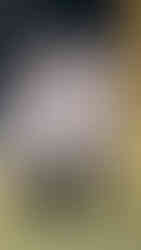


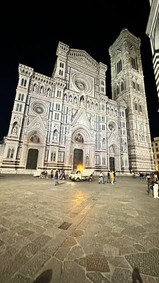


























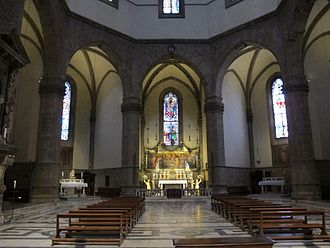
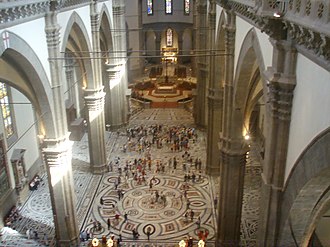









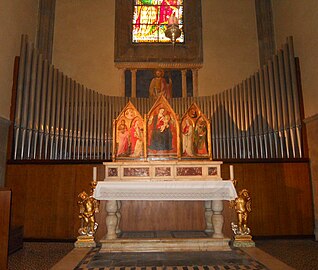

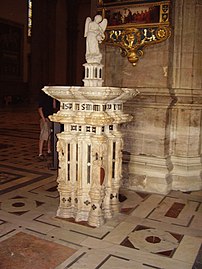
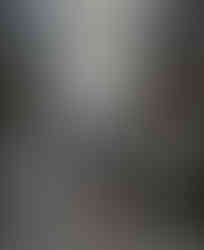

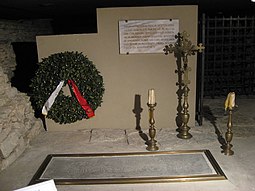





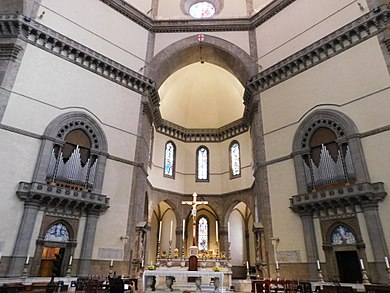

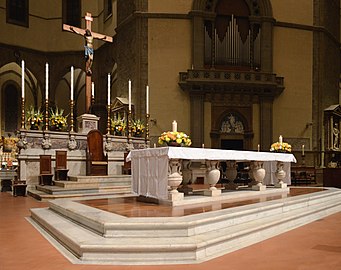

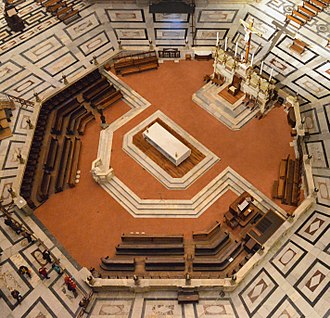


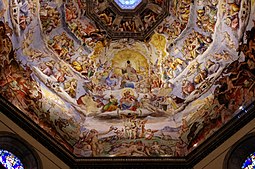



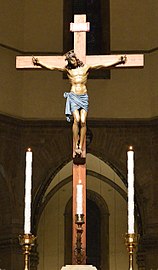

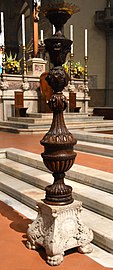

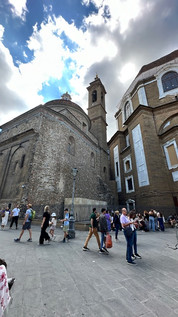








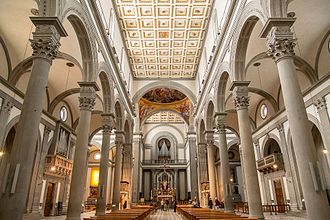

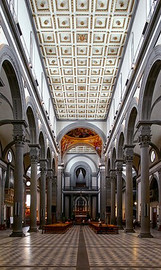
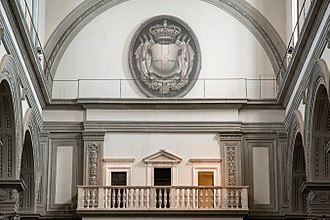

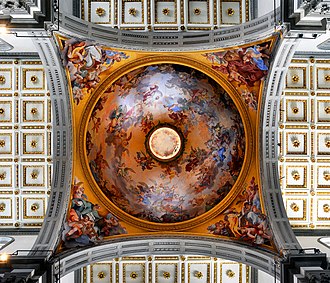









































































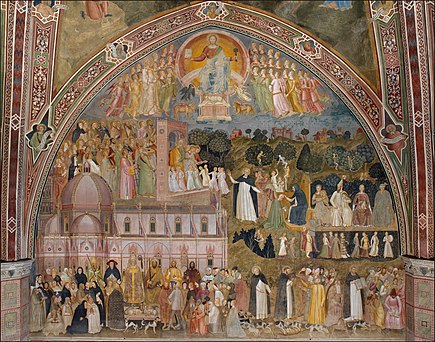



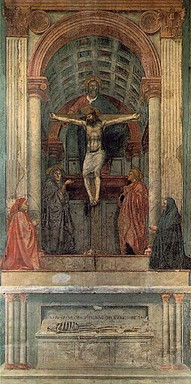
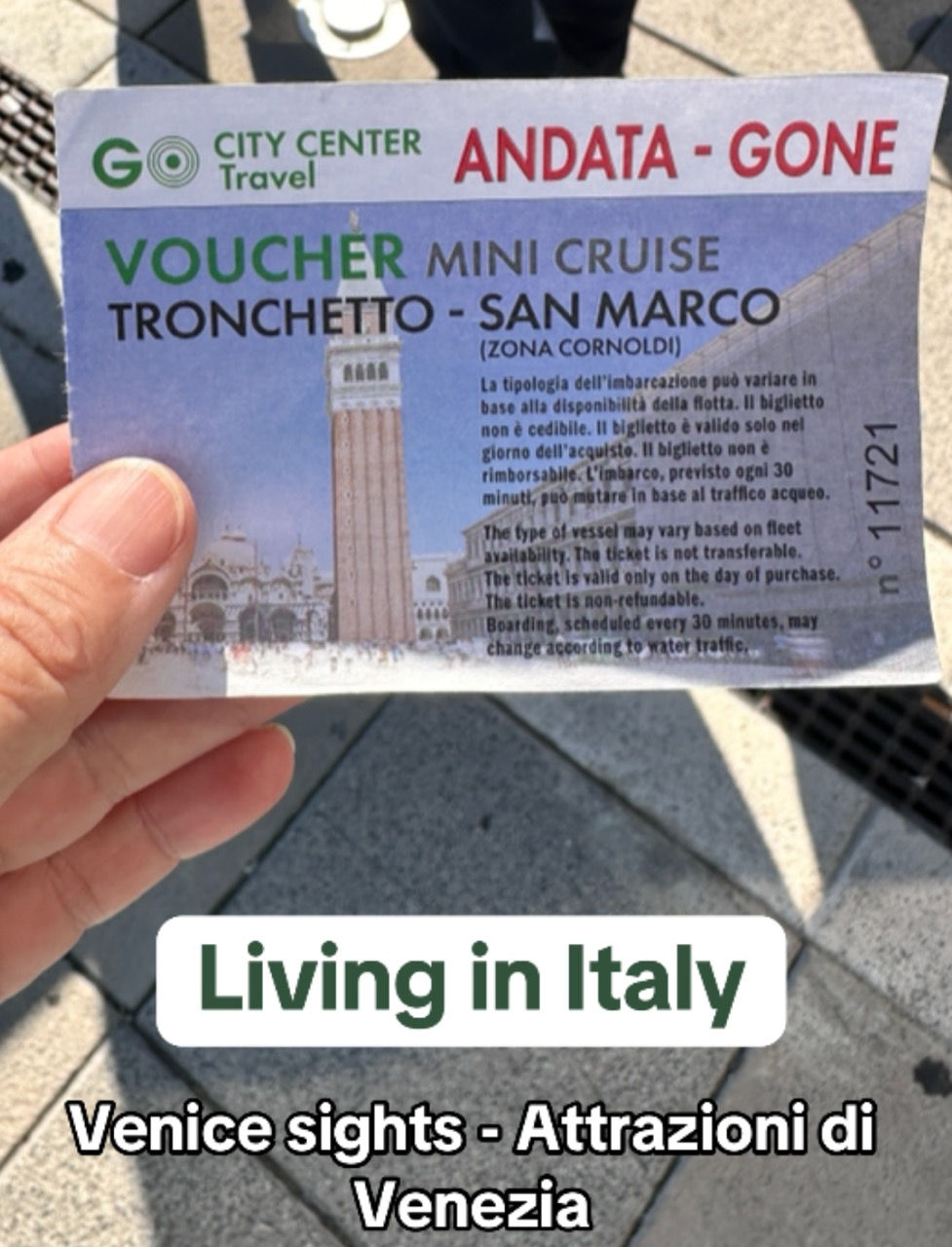


コメント